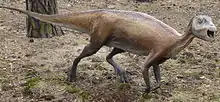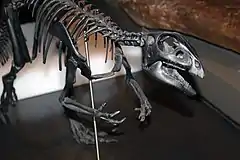Wonthaggi Formation
The Wonthaggi Formation is an informal geological formation in Victoria, Australia whose strata date back to the Early Cretaceous. It is part of the Strzelecki Group within the Gippsland Basin. Dinosaur remains are among the fossils that have been recovered from the formation.[1][2] It is partially equivalent to the Eumeralla Formation.
| Wonthaggi Formation Stratigraphic range: Valanginian–Barremian | |
|---|---|
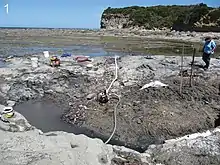 Flat rocks locality | |
| Type | Geological formation |
| Unit of | Strzelecki Group |
| Underlies | Unconformity with Wombat Volcanics & Kersop Arkose |
| Overlies | Paleozoic basement |
| Thickness | Up to 2,500 m (8,200 ft) |
| Lithology | |
| Primary | Volcaniclastic sandstone, siltstone |
| Other | Conglomerate, coal |
| Location | |
| Coordinates | 38.7°S 145.7°E |
| Approximate paleocoordinates | 77.0°S 117.5°E |
| Region | |
| Country | |
| Extent | Gippsland Basin |
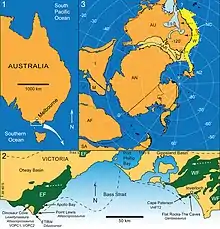 Exposure of Wonthaggi Formation green in bottom-right | |
Geology
The Wonthaggi Formation was deposited within the extensional rift valley formed between Australia and Antarctica. The lithology primarily consists of fluvially deposited siliciclastics derived from volcanic rocks of the Whitsunday Silicic Large Igneous Province to the East, with suggestions that the sediments either originated from braided river and sheet flood deposits, or meandering river systems on vegetated floodplains.[3] The age of the formation is thought to be Valanginian to Barremian, with the Flat Rocks site being late Barremian (~125 Ma) in age, older than the sediments from the Eumeralla Formation, which are thought to be Aptian-Albian in age.
Vertebrate paleofauna
Indeterminate ornithopod remains are present in Victoria, Australia.[3] Indeterminate megaraptorid remains are present in Victoria, Australia.[4]
| Dinosaurs of the Wonthaggi Formation | ||||
|---|---|---|---|---|
| Genus | Species | Locality | Notes | Images |
|
cf. A. loadsi[3] |
Flat Rocks |
| ||
|
F. australe[1] |
Considered a nomen dubium.[3] | |||
|
G. dorisae[3] |
Flat Rocks |
Known from a maxilla | ||
|
Q. intrepidus[1] |
Flat Rocks |
"[Three] dentaries and teeth."[5] | ||
|
S. arthurclarkei[1] |
The Arch, Kilcunda |
|||
|
Indeterminate |
Possibly also present at the Eumeralla Formation (footprints). |
Single furcula. | ||
| Ankylosauria[7] | Indeterminate | Flat Rocks | Teeth, dorsal vertebra, ribs, osteoderms | |
| Noasauridae[8] | Indeterminate | San Remo Member | NMV P221202, astragalocalcaneum | |
| Ornithopoda[3] | Indeterminate | Flat Rocks | Dentaries referred to as "Victorian ornithopodan dentary morphotype 3" including P228408, NMV P231182, NMV P199135 and isolated teeth | |
| Amphibians of the Wonthaggi Formation | ||||
|---|---|---|---|---|
| Genus | Species | Presence | Notes | Images |
| Koolasuchus | K. cleelandi | Tree Trunk Point, Dwyers Hill, San Remo | Chigutisaurid temnospondyl, last known temnospondyl | 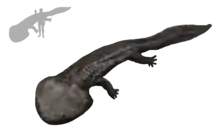 |
| Mammals of the Wonthaggi Formation | |||||
|---|---|---|---|---|---|
| Genus | Species | Presence | Material | Notes | Images |
| Ausktribosphenos | A. nyktos | Flat rocks | Partial dentary with teeth | Ausktribosphenid | |
| Bishops | B. whitmorei | Partial dentary with teeth | Ausktribosphenid | ||
| Corriebaatar | C. marywaltersae | "NMV P216655, a fragment of a left dentary bearing a complete plagiaulacoid p4 and the anterior root of m1" | Multituberculate |  | |
| Kryoparvus | K. gerriti | Partial dentary with teeth | ?Ausktribosphenid | ||
| Teinolophos | T. trusleri | Partial dentary with teeth | Monotreme | ||
See also
- List of dinosaur-bearing rock formations
- South Polar region of the Cretaceous
References
- Weishampel, David B; et al. (2004). "Dinosaur distribution (Early Cretaceous, Australasia)." In: Weishampel, David B.; Dodson, Peter; and Osmólska, Halszka (eds.): The Dinosauria, 2nd, Berkeley: University of California Press. Pp. 573-574. ISBN 0-520-24209-2.
- . "Wonthaggi Formation", Australian Stratigraphic Units Database, Geoscience Australia, retrieved 2011-09-18
- Herne, Matthew C.; Nair, Jay P.; Evans, Alistair R.; Tait, Alan M. (2019). "New small-bodied ornithopods (Dinosauria, Neornithischia) from the Early Cretaceous Wonthaggi Formation (Strzelecki Group) of the Australian-Antarctic rift system, with revision of Qantassaurus intrepidus Rich and Vickers-Rich, 1999". Journal of Paleontology. 93 (3): 543–584. doi:10.1017/jpa.2018.95.
- Poropat, Stephen F.; Martin, Sarah K.; Tosolini, Anne-Marie P.; Wagstaff, Barbara E.; Bean, Lynne B.; Kear, Benjamin P.; Vickers-Rich, Patricia; Rich, Thomas H. (2018-04-03). "Early Cretaceous polar biotas of Victoria, southeastern Australia—an overview of research to date". Alcheringa: An Australasian Journal of Palaeontology. 42 (2): 157–229. doi:10.1080/03115518.2018.1453085. ISSN 0311-5518.
- "Table 18.1," in Weishampel, et al. (2004). Page 395.
- Martin, Anthony J.; Vickers-Rich, Patricia; Rich, Thomas H.; Hall, and Michael (2014). "Oldest known avian footprints from Australia: Eumeralla Formation (Albian), Dinosaur Cove, Victoria". Palaeontology. 57 (1): 7–19. doi:10.1111/pala.12082.
- Barrett, Paul M.; Rich, Thomas H.; Vickers-Rich, Patricia; Tumanova, Tat'yana A.; Inglis, Matthew; Pickering, David; Kool, Lesley; Kear, Benjamin P. (September 2010). "Ankylosaurian dinosaur remains from the Lower Cretaceous of southeastern Australia". Alcheringa: An Australasian Journal of Palaeontology. 34 (3): 205–217. doi:10.1080/03115511003655430. ISSN 0311-5518.
- Brougham, Tom; Smith, Elizabeth T.; Bell, Phil R. (2020-01-29). "Noasaurids are a component of the Australian 'mid'-Cretaceous theropod fauna". Scientific Reports. 10 (1): 1428. doi:10.1038/s41598-020-57667-7. ISSN 2045-2322.
